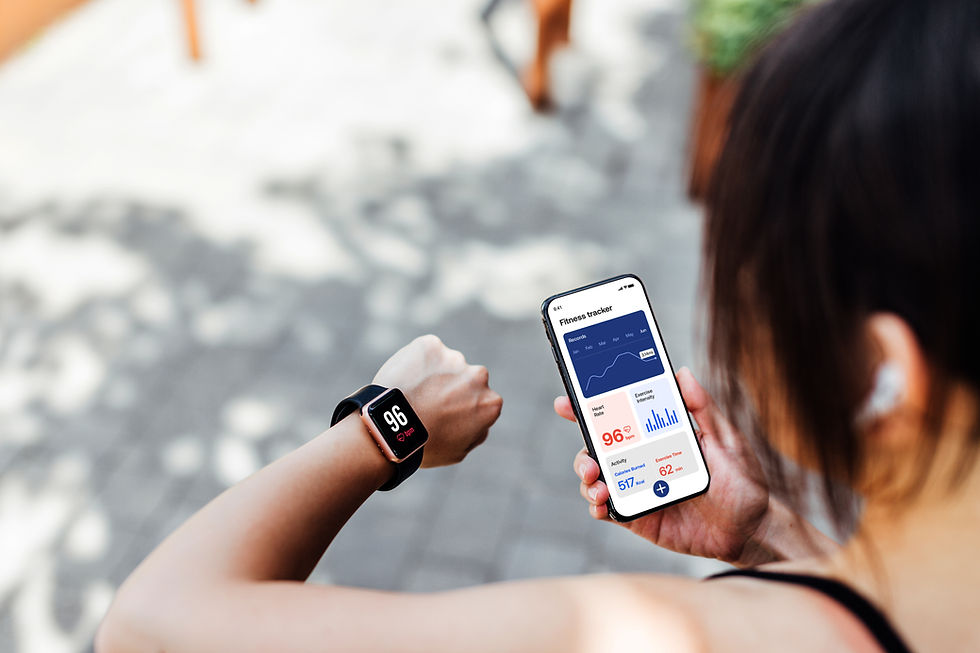The Role of Heart Data in Predicting Cardiovascular Issues
- 199dominator
- Oct 9, 2023
- 6 min read

I. Introduction
Introduction to Cardiovascular Health: Cardiovascular diseases stand as the leading cause of mortality globally, encompassing a wide range of conditions affecting the heart and blood vessels. These diseases not only affect longevity but significantly impact the quality of life.
The Power of Heart Data: With the advent of advanced technology, the collection and analysis of heart data have become pivotal in understanding and predicting cardiovascular issues. Heart data, comprising intricate details about the heart's rhythm, electrical activity, and overall function, offers profound insights into cardiac health.
Aim of the Blog Post: This blog post aims to explore the dynamic world of heart data, shedding light on its components, the technologies driving its collection, and its pivotal role in early detection and prediction of cardiovascular issues. Additionally, it delves into the ethical aspects and peeks into the future of cardiovascular health monitoring.
II. Understanding Heart Data
Electrocardiograms (ECGs): Electrocardiograms, commonly known as ECGs or EKGs, are fundamental diagnostic tools in cardiology. These tests measure the heart's electrical activity, showcasing its rhythm and detecting any irregularities. ECGs play a critical role in diagnosing various heart conditions, from arrhythmias to myocardial infarctions.
Heart Rate Variability (HRV): Heart Rate Variability (HRV) is the variation in time between successive heartbeats. It serves as a valuable metric, reflecting the heart's ability to adapt to different situations. High HRV indicates a healthy, responsive cardiovascular system, while reduced HRV might signify stress, fatigue, or potential heart issues.
Continuous Monitoring: Traditional medical settings are transitioning towards continuous heart monitoring. Wearable devices, such as smartwatches and fitness trackers, facilitate real-time data collection. These devices offer a wealth of information, allowing individuals and healthcare professionals to monitor heart rate patterns, detect irregularities, and identify potential risks promptly.
III. Importance of Early Detection
Impact of Cardiovascular Diseases: Cardiovascular diseases exert a staggering toll on global health, causing millions of deaths each year. They encompass a broad spectrum of conditions, including coronary artery disease, heart failure, arrhythmias, and more. Beyond mortality, these diseases significantly diminish the quality of life for those affected.
Early Detection Saves Lives: Early detection emerges as a potent weapon in the battle against cardiovascular diseases. Detecting issues at an early stage allows for timely interventions, potentially preventing the progression of the disease. It can also lead to better treatment outcomes and a higher chance of recovery.
Outcomes and Health Cost Reduction: The benefits of early detection extend to both individuals and healthcare systems. Early intervention often translates into lower healthcare costs and fewer resources expended on advanced treatments. Moreover, it can mitigate the personal and societal burdens associated with long-term cardiovascular disease management.
IV. Wearable Technology and Heart Data
Evolution of Wearable Technology: The evolution of wearable technology has been nothing short of remarkable. From basic fitness trackers to advanced health monitoring devices, wearables have become an integral part of modern healthcare. These devices offer continuous heart data monitoring, enabling individuals to take charge of their health.
Accuracy and Reliability: Consumer-grade wearable devices have undergone significant advancements in terms of accuracy and reliability. Their ability to collect and analyze heart data, including ECGs and HRV, has empowered individuals to track their heart health with confidence.
Research Findings: Recent studies and research findings attest to the effectiveness of wearable devices in detecting and predicting cardiovascular issues. Notable research published in reputable journals have demonstrated the ability of these devices to detect atrial fibrillation (AFib) and other heart conditions accurately.
V. The Role of Artificial Intelligence and Machine Learning
Introduction to AI and ML in Healthcare: Artificial Intelligence (AI) and Machine Learning (ML) have revolutionized healthcare by enabling data analysis at an unprecedented scale and speed. These technologies offer the potential to process vast amounts of heart data, identify patterns, and make predictions with a high degree of accuracy.
Data Analysis Potential: Machine learning algorithms excel in analyzing complex datasets, making them well-suited for heart data analysis. They can discern subtle patterns, correlations, and anomalies in heart data, which can be invaluable in predicting cardiovascular issues.
Case Studies: Highlight case studies and research papers that exemplify the successful application of AI and ML in predicting cardiovascular issues. These studies showcase how machine learning algorithms have been trained to recognize specific heart patterns associated with various cardiac conditions.
1. Apple Heart Study:
Background: The Apple Heart Study, conducted in partnership with Stanford Medicine, enrolled over 400,000 participants.
Method: The study leveraged the Apple Watch's built-in optical heart rate sensor and ECG app to detect atrial fibrillation (AFib) episodes.
Findings: The study found that the Apple Watch could accurately detect AFib, showcasing its potential for early AFib detection.
Significance: This case study underscores the effectiveness of consumer-grade wearable technology in early AFib detection, potentially saving lives through timely interventions.
2. Cardiogram's DeepHeart Study:
Background: Cardiogram's DeepHeart Study used deep learning algorithms to analyze heart rate and step count data from wearables.
Method: The study successfully predicted conditions such as diabetes, hypertension, and sleep apnea based on heart rate patterns.
Findings: Deep learning algorithms demonstrated the ability to detect these conditions early, offering opportunities for proactive healthcare.
Significance: This case study exemplifies how AI-driven analysis of heart data can lead to early detection and prevention of major health issues, improving overall well-being.
3. The Framingham Heart Study and ML:
Background: The Framingham Heart Study is a renowned cardiovascular study that has collected extensive data over decades.
Method: Machine learning models were applied to the long-term data to predict cardiovascular risk factors and outcomes.
Findings: AI-driven analysis of historical data enhances our ability to predict and prevent cardiovascular issues.
Significance: This case study highlights the importance of long-term data in training AI models for accurate predictions, offering valuable insights for healthcare practitioners.
4. Detection of Cardiac Arrhythmias:
Background: This case study focuses on the application of AI and ML algorithms to detect cardiac arrhythmias, including atrial fibrillation (AFib).
Method: Advanced algorithms exhibit high sensitivity and specificity in identifying irregular heart rhythms.
Findings: Early detection of arrhythmias can lead to timely interventions, ultimately improving patient outcomes.
Significance: This case study emphasizes the potential of AI and ML in identifying critical heart conditions, enabling proactive healthcare management.
These case studies vividly demonstrate the transformative power of artificial intelligence and machine learning in cardiovascular health. They showcase how these technologies harness heart data to detect and predict cardiovascular issues, offering opportunities for proactive and personalized healthcare.
Upcoming Technologies:
Advanced Wearable Devices: The future of cardiovascular health monitoring will witness the emergence of highly advanced wearable devices. These devices will not only measure heart rate and rhythm but also incorporate more sophisticated sensors for additional health parameters. Examples include wearables with enhanced ECG capabilities, photoplethysmography (PPG) for blood pressure monitoring, and even non-invasive glucose monitoring for individuals with diabetes.
Implantable Sensors: Implantable sensors and devices are poised to revolutionize heart data collection. Miniaturized implantable devices, such as cardiac monitors, can provide continuous and highly accurate heart data, making them invaluable for long-term monitoring of patients with cardiac conditions. These implants can transmit data wirelessly to healthcare providers, ensuring timely interventions.
Innovative Diagnostic Tools: Diagnostic tools will become more innovative and accessible. Handheld devices that can perform ECGs and other cardiac assessments with high accuracy will be available for home use, allowing individuals to monitor their heart health conveniently. These tools will integrate seamlessly with smartphones and other personal devices.
Genomics and Personalized Medicine:
Genomic Analysis: Genomics, the study of an individual's genetic makeup, holds immense potential in predicting cardiovascular health. Genetic predispositions to heart diseases can be identified through genomic analysis. By examining specific genetic markers, healthcare providers can assess an individual's susceptibility to certain cardiovascular conditions, allowing for targeted prevention strategies.
Personalized Treatment and Prevention: With genomics, personalized medicine will become more prevalent in cardiovascular healthcare. Treatment plans will be tailored to an individual's genetic profile, ensuring the most effective interventions. For example, individuals at higher genetic risk for heart disease may receive more aggressive prevention measures, while those at lower risk may follow less intensive strategies.
Predicting Future Trends:
Integration of AI with Wearables: Artificial intelligence will play an increasingly integral role in heart data analysis. Wearable devices will incorporate AI algorithms to provide real-time insights into heart health. These algorithms will not only detect irregularities but also offer personalized recommendations for maintaining cardiovascular well-being.
Non-Invasive Diagnostic Techniques: The development of non-invasive diagnostic techniques will reduce the need for invasive procedures. Technologies like advanced imaging and blood biomarker analysis will enable the early detection of cardiovascular issues without the need for surgeries or catheterizations, making diagnostics safer and more accessible.
Telemedicine and Remote Monitoring: Telemedicine will continue to expand its role in cardiovascular care. Remote monitoring of heart data will become more prevalent, allowing patients to receive expert guidance from the comfort of their homes. Healthcare providers will have access to real-time data, enabling timely interventions and reducing the need for in-person visits.
These future trends and innovations signify a promising era in cardiovascular health monitoring. As technology continues to advance, individuals will have greater control over their heart health, with access to more accurate data, personalized treatment strategies, and convenient monitoring options. This evolution holds the potential to significantly reduce the burden of cardiovascular diseases worldwide.




Comments